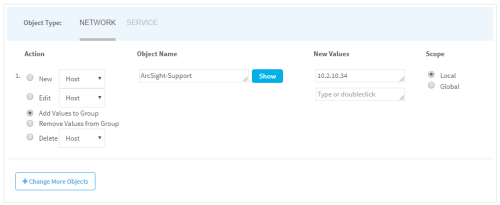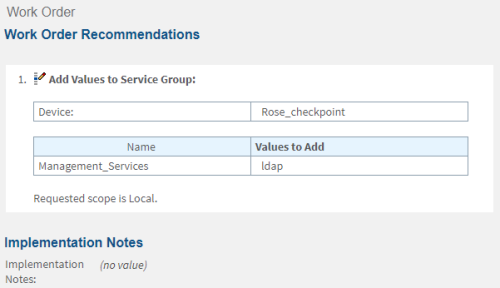Object change workflow
This topic describes the events that occur in each stage in a default object change workflow.
Note: FireFlow is fully configurable, and your system may differ.
Request
- The requesting privileged user selects a template on which to base their request.
- If the template specifies a workflow, FireFlow assigns the request to that workflow.
-
The requesting privileged user submits the request to FireFlow.
The request includes information about a device object to create, delete, or modify.
For example, the requesting privileged user may submit the following request:
Note: Check Point devices have a more extensive list of possible actions.
- FireFlow receives the request information and creates a change request.
- If a workflow has not yet been assigned, FireFlow assigns a workflow. For more details, see Request templates and workflows.
- The default assignee of the role handling new change requests (by default, the Network Operations role) is assigned as the change request's owner.
- FireFlow sends an email message informing the requesting privileged user that the change request was created, and specifying the change request ID in the format [FireFlow #<number>], for example [FireFlow #49].
Plan
In the Plan stage, a user with the network operations role plots out the technical changes needed in order to satisfy the change request. This stage consists of the following steps:
-
The change request may change ownership in one of the following ways:
- The change request owner assigns it to a user with network operations role.
- A network operations user chooses to take responsibility for the change request.
-
FireFlow initiates a search for rules that would be affected by the requested object change.
FireFlow returns a list of affected rules:
You can view details by clicking the details link:
Approve
The Approve stage consists of the following steps:
-
The default assignee of the role handling change requests in the Approve stage (by default, the Information Security role) is assigned as the change request's owner.
-
The change request may change ownership in one of the following ways:
- The change request owner assigns it to a user with the information security role.
- An information security user chooses to take responsibility for the change request.
-
The information security user does one of the following:
- Approves the change request and sends it on to the next stage.
- Rejects the change request. In this case the change request returns to the start of the Approve stage.
- Rejects and closes the change request. In this case, an email message is sent to the requesting privileged user, indicating that the request is denied.
- Contacts the requestor and asks for more information.
Implement
In the Implement stage, the network operations user plans and executes request implementation. This stage consists of the following steps:
-
The change request's ownership is returned to the network operations user.
-
FireFlow creates a work order and displays a list of recommendations for implementing the requested change.
- The network operations user edits the work order, by adding notes to the work order.
- The network operations user implements the requested changes on the security device according to the work order, by using the relevant management system (for example, Check Point Dashboard or Juniper NSM) to implement the changes.
- The network operation user sends the change request on to the next stage.
Validate
In the Validate stage, the network operation user validates the implemented device object changes against the change request. This stage consists of the following steps:
-
The network operations user validates the implemented device policy changes against the change request.
- If validation indicates that the implemented changes did not achieve the desired result specified in the change request, then the network operations user re-initiates the Implement stage.
- The network operations user composes an email message in FireFlow, notifying the requestor that the requested changes were implemented.
- FireFlow sends the email to the requesting privileged user.
- The network operations user resolves the change request.
At this point, the change request's lifecycle has effectively ended, and no further user action is required. However, the change request remains available in the system for auditing purposes, as described in the final stages.
Resolved
Once the change request has been validated, it enters the Resolved stage.
Audit
The Audit stage for object change request lifecycles is identical to the Audit stage for traffic change request lifecycles. See Audit.






